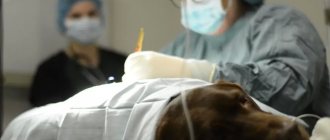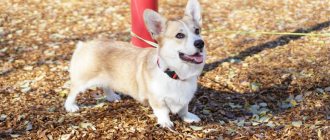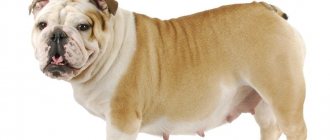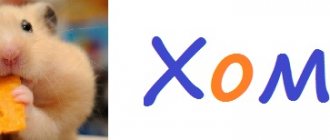A nursing dog needs a special balanced diet, since during lactation it gives a lot of useful substances from its body to newborn puppies along with milk. Thus, a varied diet will help prevent possible problems associated with the growth of the offspring and the health of the mother.
Feeding during pregnancy
Natural type
So, at the first stage (the first 5 weeks) no changes in diet are required, but this is only if the owner did not skimp on feeding before mating.
It’s probably stupid to mention this, but nevertheless, we often come across such a practice when owners, having invested a lot of money and effort into their pet at the growing stage (so that there are no problems in the dog’s growth and development), then “relax”, believing that the diet can be “cheapened” and no bad consequences will occur. It's a delusion!
If a pregnant dog is initially conscientiously prepared for mating, then only during the first month of pregnancy can the diet not be changed. During this period, it is necessary to monitor the dog for changes in its behavior. They often experience periods similar to mild toxicosis in women in early pregnancy. No, of course they don’t vomit, but loss of appetite happens quite often.
If the diet is initially not rich in proteins, vitamins and minerals (there is usually no shortage of carbohydrates), then it is necessary to review and balance it, otherwise a pregnancy that has just begun may suddenly end, and possibly with bad consequences.
Products for natural dog feeding
Experienced dog breeders recommend not to “press” the dog with food, but to leave a bowl of food freely available for it - if it wants, it will eat. This is where two main differences in the type of nutrition “pop up”.
Firstly, with a natural type, this technique may not be suitable - natural food is a quickly perishable product.
Eating sour food is unacceptable for a pregnant dog. In this matter, dry food definitely wins. Secondly, natural food must be prepared according to a pre-calculated recipe, using an additional source of vitamins and minerals.
Further, at the 6th week of pregnancy, the embryos are already sufficiently formed and enter the active growth phase. The expectant mother already has a noticeable rounded belly and her appetite begins to grow in proportion to the puppies in the womb.
At this time, the diet begins to increase. Typically this is +10-15% of the total food each week. Food should be easily digestible and rich in vitamins, but with a moderate content of minerals, especially Ca (calcium). Its excess in the later stages can cause a severe form of toxicosis that is life-threatening for the dog - eclampsia.
Simultaneously with increasing the volume of food, the frequency of feedings should be increased. A pregnant dog cannot eat food the same way as before pregnancy; it is too difficult for her because... The increased size of the uterus significantly tightens the abdominal organs, and primarily the stomach. Therefore, you need to reduce the amount of food per feeding and increase the frequency of feedings. The number of “approaches” to the bowl may vary, depending on the individual characteristics of the dog, but not less than 3 at 6 weeks of pregnancy and further, in increasing order. Ultimately, the daily amount of food increases by 1.5 times.
Drinking water for the expectant mother should be clean, fresh, cool and always available so that she can drink to her heart's content.
You can increase your diet only with foods containing protein and vitamins. These substances are extremely necessary for the “construction” of organs and tissues of puppies. If a pregnant dog for some reason does not receive them in the required quantities, then her body will be forced to give these elements from its own resources. But it’s better to balance protein and fat in your diet with vegetables.
Warning! During pregnancy, it is necessary to monitor the dog's live weight. By the time of birth, your weight should not exceed normal by more than 12%!
Excessive or incorrectly balanced feeding can lead to pregnancy pathologies, miscarriages and premature birth. Also, excess weight has a destructive effect on the course of labor and the body of the dog itself.
From 41-42 days of pregnancy, the dog is transferred to a “lactation” diet, which should be more high-calorie, without increasing the volume of food mass, but more on that later.
In the third month of pregnancy, puppies actively gain weight, loading the mother’s musculoskeletal system. The dog gets tired quickly from such a load, it needs more and more time to rest, which makes it calmer. This also affects appetite - sometimes you can observe a decrease in it or a complete refusal to eat. But this phenomenon should not be permanent. Refusal to eat for 2 days in a row, combined with refusal of water, lethargy, discharge from the loop with an unpleasant odor, is a cause for concern and a visit to the veterinarian, with the exception of a harbinger of labor. About a day or two before giving birth, the dog refuses food, but not water. This can be explained, for example, by the onset of contractions.
Advice! Throughout the entire period of pregnancy (and further, during the lactation period, while the dog feeds the puppies with its own milk), with a natural type of feeding, additional vitamin, vitamin and mineral complexes must be introduced into the diet.
When feeding dry complete food of at least “premium” class, an additional source of vitamins and minerals is not required.
Vitamins for dogs
Vitamin and mineral supplements for pregnant bitches with natural type
Any vitamin and mineral complexes fall into this category, from the good old domestic Fitocalcevit and Farmavit Neo to branded ones like Exel 8 in 1 (USA).
The list can be very long: Beaphar (Netherlands), Kanina (Germany), Polydex (Great Britain), Gelakan and Kanvit (Czech Republic), Volmar (Switzerland), etc.
Food products suitable for a natural diet for a pregnant dog:
Sources of protein (protein)
These products include everything that is of animal origin. Suitable for dog diet:
- meat;
- offal;
- meat and bone meal;
- fish;
- lactic acid products, preferably yogurt and cottage cheese;
- eggs, especially whites, but in limited quantities.
Zhirov
Fats contain neutral fats, fatty acids, fat-soluble vitamins and many other substances important for metabolism. They satisfy the dog’s energy needs by 20-25%.
- chicken fat;
- pork fat;
- fish fat;
- corn oil;
- chicken egg yolks;
- sunflower oil.
Carbohydrates
Carbohydrates make up the largest portion of a dog's diet. Basically, they provide the energy value of the diet, providing the dog not only with energy, but also with fiber.
- vegetables;
- cereals, cereals.
Dry dog food
Special dry food
Feeding a dog with dry food is disproportionately easier than with “natural” food. The main thing here is to choose food. Otherwise everything is similar, but simpler.
During the first 5 weeks, there is no need to change anything in the diet; at the 6th week of pregnancy, just as with the natural type of feeding, it is necessary to increase the daily amount of feed by 10-15% per week and introduce additional feedings (dividing the daily amount into the number of feedings). There should be at least 3 meals in total at this stage.
In the last month of gestation, from 40-42 days, there is a need to switch the pregnant pet to food preferred for the lactation period. It should be a feed with a higher energy content. These foods include puppy foods marked “Pappy”. Of course, there are differences in such food for dogs of different sizes, but each manufacturer has separate lines of food for dogs of different sizes, and each line contains puppy food.
Proven dry food for pregnant and lactating dogs from breeders and veterinarians includes:
- Royal Canin Starter;
- Bosch Reproduction;
- Pro Plan Performance (Purina);
- Hill's Puppy;
- Eukanuba Puppy Starter;
- Brit Care Puppy.
Canned food for nursing dogs
Brief conclusions
- The diet of a nursing dog must first of all be biologically appropriate, that is, based on meat products. If this is the case, no special feed is needed, and the increased energy and nutrient requirements are easily compensated for by increasing the feeding rate.
- Properly selected dry food solves many problems. And it is wise to transfer a bitch intended for breeding to him in advance.
- There is no need to add any vitamin, mineral or other supplements to the complete food unless they are prescribed by a veterinarian.
- Clean, fresh drinking water is an integral part of a nursing dog’s diet, because the body needs to replenish the fluid used to produce milk.
What to feed after childbirth
Feeding a dog that has given birth is an extremely serious matter. This is due to the fact that they are polyploid animals, which can have up to 15 puppies in a litter during one birth. This is a colossal burden for the mother’s body.
Mother's milk for puppies is the only food for the next 1-1.5 months. In addition, during the first day or two, the mammary glands of all mammals, including dogs, secrete not milk, but colostrum. This exceptional substance contains a concentrate of vitamins, microelements, nutrients and, most importantly and uniquely, ready-made antibodies to those infectious diseases that the mother herself has. These are the infections that were either vaccinated or that the dog suffered from.
Therefore, with a large litter, it is very important to feed the dog correctly, because its colostrum, and subsequently milk, should be enough for all puppies in sufficient quantities. If a shortage is still felt, we recommend using a special substitute for bitch milk.
In order for milk to be nutritious and provide energy in the required amount to all puppies, the mother’s diet must also be high in calories, but at the same time, it is desirable that the food does not take up large volumes because a dog, getting used to a large amount of food, undergoes inevitable stretching of the stomach walls, which ultimately leads to diseases of the gastrointestinal tract and endocrine system.
If before the onset of labor the dog usually refuses to eat, then after the birth it must be given a drink and offered to eat in order to regain strength.
After childbirth is over, the young mother’s appetite will increase for the first 3-4 weeks. Depending on the number of puppies in the litter, you need to increase the daily ration and, accordingly, the frequency of feeding.
Meat is the main component
Natural type
The quality of the diet also changes slightly in a more “intensive” direction. This means that caloric intake must be significantly increased. A veterinarian or an experienced breeder who specializes in the specific breed of interest will help you calculate the diet in more detail. So, for example, a German Shepherd weighing 32-35 kg and nursing a litter of 8 puppies will require a diet with a calorie content of 4500 kcal/kg, and it will need to contain approximately 30% protein and 20-25% fat in relation to dry matter volume.
The products used to create a natural diet are the same as for a pregnant dog, but mineral complexes (mineral-vitamin) and supplements in the form of meat-and-bone or fish meal are necessarily added.
Vitamin and mineral complexes for dogs nursing puppies are the same ones that were used during the gestation period.
Dry food
This option is much simpler. It does not require additional sources of vitamins and minerals and has clear dosing instructions from the manufacturer. In addition, there is no need to change food after birth because the food that was used at the last stage during gestation of puppies is quite suitable for the lactation period.
Diet for eclampsia
Pugs and Jack Russell Terriers often develop eclampsia after giving birth. This disease occurs due to a lack of calcium in the body. The main symptoms of the disease include:
- increased body temperature;
- shortness of breath and increased heart rate;
- deterioration of coordination and loss of balance;
- weakness, due to which the dog may be unconscious;
- loss of appetite;
- dilated pupils;
- convulsions.
Important! If the above symptoms appear, you need to call a veterinarian to come and examine the dog.
During treatment of eclampsia, it is better to exclude solid foods from the diet. Instead, the pet is given more broths and soups.
Size differences
Oddly enough, the principle of feeding pregnant and lactating dogs practically does not depend on their size. Yes, yes, almost all the rules will be the same for both the small Italian lapdog and the huge Caucasian Shepherd. Here, the quality of the feed and its compliance in terms of calorie content, protein content, vitamins and minerals plays a more important role.
For natural type
This means that with a natural type of feeding, the products may remain the same as usual, but with the necessary adjustments to the required indicators. An experienced dog breeder can cope with this task without much difficulty. If you have little experience in this matter, then you need to contact either more experienced “comrades in arms” or a veterinary clinic for advice on such feeding.
The dog Masha fed her newborn puppies
When using dry food
When feeding dry food, you must stick to the normal line that was used before pregnancy. Those. for large breeds (adult dog weight over 45 kg) - food marked GIANT.
The packaging of such food, intended for puppies of such large breeds, will have the appropriate name Starter, Babydog or Puppy. This is the food that was discussed in the sections “Feeding pregnant dogs” and “Feeding nursing dogs.” This food is necessary for the dog in the last month of gestation and in the first 1-2 months after birth.
- For dogs whose adult weight is 25-45 kg, food marked MAXI is intended.
- For dogs with an adult weight of 10 to 25 kg, marked MEDIUM.
- For dogs of various mini breeds whose adult weight does not exceed 10 kg, the food is marked MINI/Starter/Babydog/Puppy.
Thus, for small breeds in the last third of pregnancy and the first 1-2 months. after giving birth, you will need food labeled MINI /Starter/Babydog/Puppy, for an English Spaniel - MEDIUM /Starter/Babydog/Puppy, for a German Shepherd - MAXI /Starter/Babydog/Puppy, and for Alabai GIANT Starter/Babydog/Puppy.
Touching photos
“Look, I tried my best”
What breed do you think? Write your answer in the comments!
Cane Corso
German Shepherd
Border Collie
Bulldog again!
Labrador or retriever? Read our article Loyal friends Golden Retriever and Labrador: 5 differences
Chow chow
“Are these all mine?”
101 Dalmatians
Rottweiler with children
Husky , husky or malamute ?
Shar Pei with his pies
The happiest pregnant beauty!
How to stimulate milk production in a pregnant bitch
The question is relevant not only for dogs. First, make sure that such stimulation is necessary.
The main sign of a lack of milk or its insufficient nutrition will, of course, be hungry puppies. They will get restless, crawl around and squeak.
The mother will feed them reluctantly, constantly being distracted by extraneous stimuli, and will constantly try to leave. This behavior is associated with a lack of milk and sore nipples when trying to feed.
What needs to be done to ensure that a dog that has given birth produces more milk. This can be done in several ways.
- Introduce liquid foods, fermented milk products (fermented baked milk, yogurt, etc.) into the diet and be sure not to limit drinking water and monitor its purity.
- Physical stimulation of nipples and mammary glands. Light massage of the mammary glands and even pumping trigger the production of oxytocin in the brain, the hormone responsible for the process of milk production. When puppies suck milk, they massage the mammary gland with their paws, and the nipple itself with their mouth (babies do this in almost all mammals, including humans). In dogs, as a rule, the last pair of nipples is more productive, so it makes sense to place the weakest puppies on them first, and the strongest ones on the first pair, so that the puppies develop them “stronger”. After the weak ones have had their fill, they can be swapped with the strong ones.
- Introduce walnuts into your dog's diet - 1 walnut three times a day, crushed, along with food, as a medicine.
- Application of the biostimulator "Apilak". This is a medical product that has contraindications. Before using it, you must, at a minimum, read the instructions, and at maximum, consult a veterinarian.
- Apply hormonal therapy. This method can only be performed by an experienced veterinarian. Self-medication in this way is unacceptable.
Postpartum toxicosis
There are cases when representatives of miniature breeds exhibit postpartum toxicosis. It is accompanied by convulsions, fear of light, fever and shortness of breath. You should not self-medicate; it is better to immediately seek help from a veterinarian. He will examine your pet and prescribe effective treatment.
A nursing dog needs careful care. In this case, special attention should be paid to the diet. Every dog breeder should know what to feed a postpartum dog and what foods it is better to avoid.
Consequences of improper feeding
It was already briefly mentioned above what will happen if the issue of feeding a pregnant dog is approached irresponsibly and carelessly, but let’s dwell on this point in a little more detail. So, what can happen if a pregnant dog is not fed correctly? More often it is:
- Miscarriage (spontaneous abortion and premature birth).
- Weak, non-viable puppies.
- Heavy or weak labor.
- Long-term recovery after childbirth.
- Lack of milk to feed puppies.
- Weakened health of the dog even after weaning the puppies, which does not allow repeated matings in the future.
Should I give dry food?
People who do not know what to feed a husky after giving birth or a nursing chihuahua often immediately give their pets dry food. However, in reality, you should not give such food thoughtlessly. It is necessary to figure out in advance what food can be given.
For lactating animals, complexes containing no more than 25% protein are suitable. Before feeding, open food must be soaked in water. It should not be given in dry form, as this can negatively affect digestion.
Broths and soups are a must-have in your pet’s diet.
Expert advice
At the request of the Zoofanat website, a practicing veterinarian gave some advice for you, our readers:
- Prepare your dog not for pregnancy, but for mating. After mating, take care of the dog, do not skimp on it, and then you will not have to fork out for its treatment.
- Before mating, do preventive treatments - treatments against ecto- and endoparasites, check the dog for dirofilariasis, carry out routine vaccinations and take a general strengthening course of vitamins.
- Before mating, if necessary, visit a groomer.
How to brush your dog’s teeth at home and what products, besides a toothbrush and toothpaste, are needed for this
In addition, we recommend purchasing an automatic dog feeder. In this case, you will be sure that your pet will receive the exact amount of food on time. In addition, it is recommended to purchase an automatic drinking bowl, which will provide your dog with clean, filtered water.
Josera Dog Family
Manufacturer – Germany. Used for puppies and pregnant and lactating females. Suitable for medium to large sized pets. This is a high-energy food to provide the animal with all the necessary nutrients and beneficial substances.
Josera Family is produced using high-quality raw materials without dyes, preservatives or flavor enhancers. The products are processed using a unique technology, making them easy to digest. The diet is rich in various microelements and vitamins:
- polyunsaturated fatty acids Omega-3 and Omega-6, ensuring the normal development of the immune system;
- calcium and phosphorus to strengthen bones and teeth;
- Vitamin E, biotin, zinc maintain good coat and skin condition.
Price: on average 1300 rubles per 4 kg.











